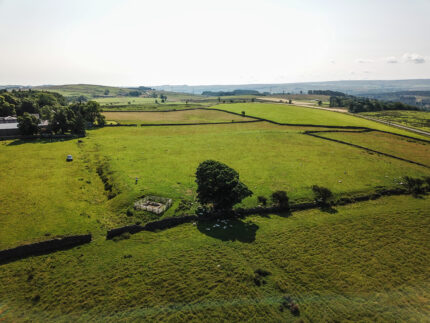Just four weeks into the excavation of Milecastle 46 on Hadrian’s Wall in Northumberland, archaeologists have already made an exceptional find: a small equal arm steelyard beam from an ancient Roman scale.
Milecastles were small forts built every Roman mile or so along defensive frontier walls. There were 80 of them along Hadrian’s Wall between the 16 major forts. Milecastle 46 was just north of the Magna fort, near what is today Carvoran, Northumberland. The Vindolanda Charitable Trust’s Roman Army Museum is located at the fort site and the Trust is in charge of the maintenance and exploration of its remains.
The impact of climate change has been altering the vegetation of the marshy land, drying out the peaty, anaerobic soil that is the reason the nearby Vindolanda fort and civilian settlement site has such exceptional preserved organic remains including thousands of leather shoes, one leather mouse, the first surviving Roman wooden toilet seat and the iconic wood writing tablets that form a unique collection of ancient correspondence unmatched in the Roman archaeological record. Magna has not been excavated systematically like Vindolanda has not been, but geophysical surveys indicate it is just as rich a source of archaeological material, and all that untapped wealth is under direct threat.
 Thanks to a hefty £1.625 million grant from the National Lottery Heritage Fund, this June the Vindolanda Charitable Trust has embarked upon a five-year, £2.5 million archaeological investigation of Magna. The first area to be excavated is Milecastle 46 and its association section of the vallum (the earthwork ditch that runs almost the entire length of Hadrian’s Wall from the North Sea to the Irish Sea). Archaeologists did not expect to find much of anything in the top layers of excavation because what little had been left of the Magna milecastle and the Wall at the site was thoroughly picked over in the 12th-14th century, the stone reused in the construction of Thirlwall Castle a half mile away. Instead, it’s only the fourth week of digging and the team has uncovered the stone foundations of Milecastle 46.
Thanks to a hefty £1.625 million grant from the National Lottery Heritage Fund, this June the Vindolanda Charitable Trust has embarked upon a five-year, £2.5 million archaeological investigation of Magna. The first area to be excavated is Milecastle 46 and its association section of the vallum (the earthwork ditch that runs almost the entire length of Hadrian’s Wall from the North Sea to the Irish Sea). Archaeologists did not expect to find much of anything in the top layers of excavation because what little had been left of the Magna milecastle and the Wall at the site was thoroughly picked over in the 12th-14th century, the stone reused in the construction of Thirlwall Castle a half mile away. Instead, it’s only the fourth week of digging and the team has uncovered the stone foundations of Milecastle 46.
The steelyard beam was found along the outer wall of the foundation on the third week of the excavation. A few centimeters of it were poking up, exposed by a night of heavy rain that had washed away the topsoil. Archaeologists didn’t know what it was at first, but once the fulcrum was exposed, its secret identity was revealed.
The 22cm [(8.7 inch)] copper alloy steelyard beam had a decorative integral central fulcrum hole to accommodate a suspension chain. One end of the beam was finished with a typical triple bevel design and delicate suspension hole from which a weighing pan would once have been hung via fine chains. The other would end would have been used to hang small weights from another chain. A feature of this steelyard is that from the fulcrum to one end of the beam are eleven evenly spaced, tiny circular silver inset points set 10mm apart, used as markers for moving the measuring weights along the arm.
A portable steelyard of this size and calibre could have been used by a proficient Roman tax official, trader or merchant for weighing small, high value items passing through the milecastle at Magna. Trading posts like this would have worked both ways, taxing goods entering and leaving the borders of the Empire. The Roman army and Emperor taking their own cut from this potentially lucrative trade.
Although not every milecastle was suitable for this purpose, number 46 at Magna, linked into a junction point of three major Roman roads, the Stanegate, the Maiden Way and the Military Road, was an ideal location for both tax and control and had clear and easy access to the north of the Wall. In the later Roman period, the flow of cut silver and glass artefacts flowed north out of the empire to buy the obedience of northern tribes. A practice which may have eventually played its part in encouraging more raiding into the province from beyond the frontier.
